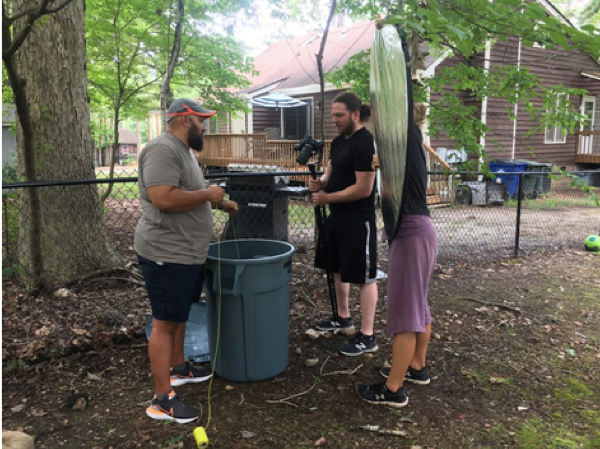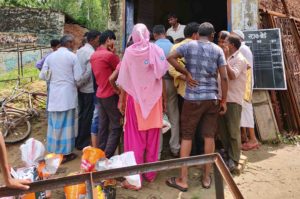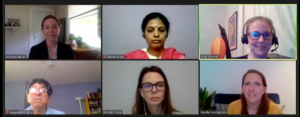Webinar Q&A: Our Guest Speakers Answer your Questions on a Virtual Training of Trainers
On Thursday, October 29th 2020, SISN hosted a webinar during which guest speakers, Chelsie Kolberg and Bryan Pride from Rise Against Hunger shared their experiences of overcoming barriers to program implementation created by COVID-19 through a case study of implementing training videos in a Nutrition-Sensitive Agriculture project at a school in South Sudan. The webinar recording can be viewed here.
An interactive discussion period followed the presentations but the number of questions received exceeded the time available to respond during the live event. Chelsie and Bryan have graciously agreed to share their answers to the outstanding questions here so that we can collectively gain insights and concrete tips to integrate into practice.
Question 1

The target group is the local school – Hope For South Sudan (HFSS). The project has two goals:
- Help HFSS become food secure through the means of growing their own food.
- Help HFSS become financially independent through income generation related to selling food grown on campus that is not consumed.
We identified HFSS as our target because we are working to build the capacity of the staff at the school. The school staff is the responsible party for growing food on campus and preparing the meals consumed by students. Since the students come and go once they have completed school, we felt that the more sustainable approach would be working directly with the school to support HFSS in becoming both financially independent of outside donors and food secure. HFSS is our local partner and the local leaders of the ELNA project. When the local leaders of a project are the implementing leads, we can expect a greater likelihood of behavior change that lead to positive outcomes related to food security and financial independence
Question 2

The goal of the project is to support HFSS in becoming food secure and financially independent, we set objectives that we believe will support HFSS in achieving the goal of the project. For example, one of the objectives is improving land utility. One of the deliverables is cultivating 300 acres of land. Using a dashboard system the HFSS team is able to report on acres expanded on a monthly basis. The monthly dashboard lets us track the progress of the project as well as empower the staff to make decisions about what activities need to be prioritized for implementation.
We are also monitoring the nutritional well-being of the students at the school through direct measurement of their height, weight and MUAC scores as well as dietary diversity. Data will be collected via CommCare, an open-source mobile platform for data collection. We have created a questionnaire for the school nurse to input data for each child on their anthropometrics. As time moves on and we both (program implementers and participants) feel more comfortable with the technology, we will expand our data collection to cover knowledge, attitudes, and practices as well as agricultural indicators. The CommCare application is used on tablets we procured for the school.
Question 3

We are piloting these videos in a rural area and we will learn much from this process as it relates to rural areas. I don’t think we have enough experience to speak on translating its implementation to urban areas right now. As far as multiple nutrition problems – nutrition tends to be complex with several factors influencing it. Those multiple barriers can only be addressed with adaptive programming that seeks to listen to the perspective of the participants.
Question 4

The South Sudan team at HFSS views the videos on the tablets that we are using to record data. Currently we are working with the school Agriculture and Cooking staff as well as the school health clinician. The head of the Agriculture staff will view the videos with the three other agriculture staff members. They will then be able to discuss amongst themselves about the videos. If the staff has questions, the questions are sent back to our technical team and they respond accordingly. After the HFSS staff feels that they understand and are capable they carry out the activities viewed in the video. The videos are released in correlation to the season and when the video activities need to be implemented. After the core staff has viewed and learned from the videos, the staff becomes the expert and wealth of knowledge, the videos will only remain as a reference source. Because the staff members become the experts, they will then be the ones who lead the farmer field school component in the 4th year of the project.
Question 5

In some of the videos masks are being worn. We hope to use these videos in the future after COVID is over. Therefore we are not mentioning preventative behaviors in the videos. But HFSS has their own precautionary measures to prevent the spread of COVID. They are taking the precautions that have been advised to them in South Sudan, therefore we have not deemed it necessary for this to be an added component of the videos.
Question 6

Currently the only virtual ToT tools that we have currently are the videos. Due to the fact that the school does not have electricity or internet, having the ability to prerecord and download the videos on to tablets, is the best way to exchange knowledge to teach the agriculture staff. In addition to the videos, the HFSS staff has the opportunity to send questions back to the Rise Against Hunger technical team in order to provide additional information. We are hopeful that through Whatsapp and monthly meeting interactions we are able to achieve this “synchronous and asynchronous” interaction.
Question 7

We will be able to share them after we complete the pilot testing. Likely, in the next few months.
Question 8

COVID-19 posed a great problem to continuing the project on time. With videos being a new method of implementation, we had to advocate for their use in programming. This was done through formative research and sensitization of our own staff and partner before deciding upon this method as a collaborative effort. Only when everyone was on-board and excited about the videos did we pursue this route. We mentioned some problems in the presentation such as cost of quality videos (with skilled videography and editing staff), long turnaround time for professional video, difficulty in finding quality translation for such a niche language, and the pressures of the ever-rotating earth forcing us to complete tasks before planting season. But it’s best to discover these early on so we have time to improve. And many of these are only true barriers one time – after that, they just become incorporated into our planning.
Question 9

I’m assuming the change in practices to mean the change in program participants’ practices. We will conduct assessments for knowledge, attitudes, practices, as well as dietary diversity, nutrition status and indicators for agriculture practices and income generation.
These videos are constantly being improved as we continue to receive feedback from our partner and we work through obstacles as we go. It will be a process of continuous improvement utilizing PDSA (Plan-Do-Study-Act) cycles where we make incremental changes with each new video.
We hope that you found this webinar and associated Q&A informative. Let’s keep the conversation going. We welcome your thoughts, comments and questions. Contact us at info@implementnutrition.org.



